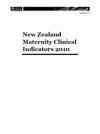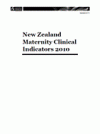The New Zealand Maternity Clinical Indicators are the result of a collaborative process involving the Ministry of Health and maternity stakeholders, representing consumer, midwifery, obstetric, general practice, paediatric and anaesthetic perspectives. Building on previous work undertaken across Australasia, an expert working group has established a set of 12 maternity clinical indicators that are relevant to the New Zealand setting and can be measured using available data collections.
This second report presents data for 2010. Data has been benchmarked using the same standardised definitions as in the previous (2009) report and is therefore comparable.
This is the second report using the standard primipara definition which allows the separate assessment of a group of women for whom interventions and outcomes should be similar. In addition to eight indicators for standard primiparae, there are also three indicators for all women giving birth in hospital and one indicator covering all babies born in hospital. Other indicators will be added over time as improved data becomes available.
This report provides an opportunity for district health boards (DHBs) and local maternity stakeholders to participate in and add value by undertaking further investigation at a local level as part of local maternity quality and safety programmes. DHBs and local maternity stakeholders can undertake early time series and trend analysis using this second full year of data.
As in the previous report, there still is variation between DHBs and between individual secondary and tertiary facilities. This variation among a group of women who would be expected to have similar outcomes (standard primiparae) needs to be investigated. Variation is seen in rates of spontaneous vaginal birth, instrumental vaginal birth, induction of labour and intact lower genital tract. These findings should encourage further detailed investigation of data quality and integrity, as well as the clinical practice management reasons for these variations.


